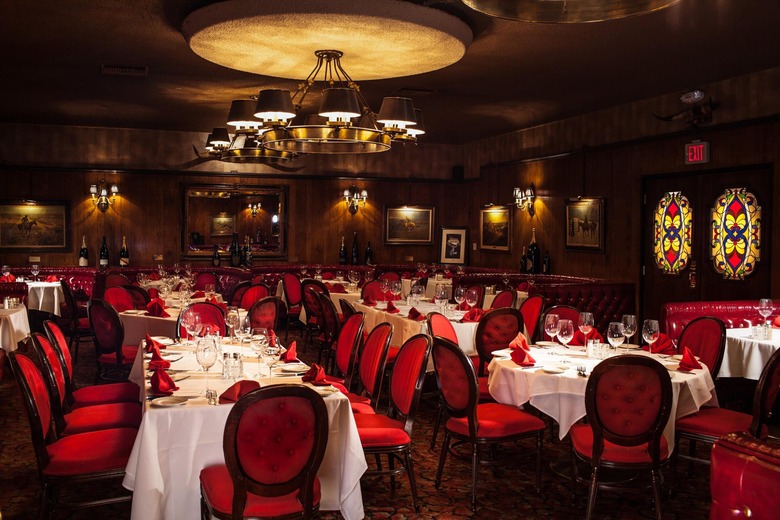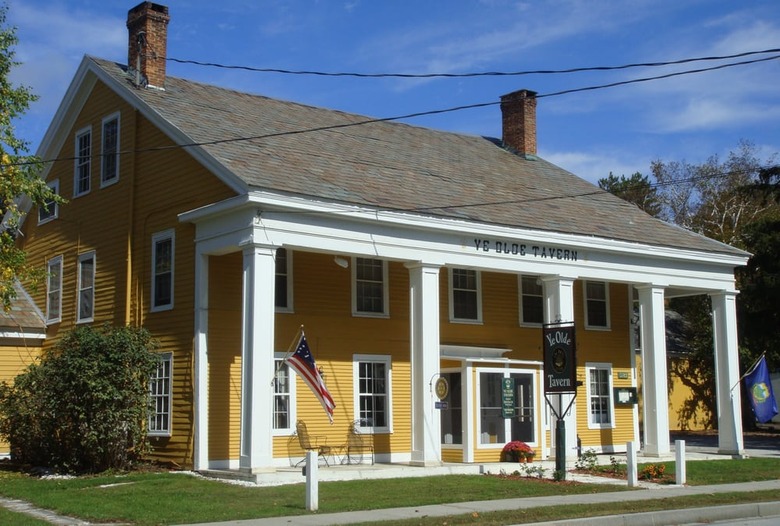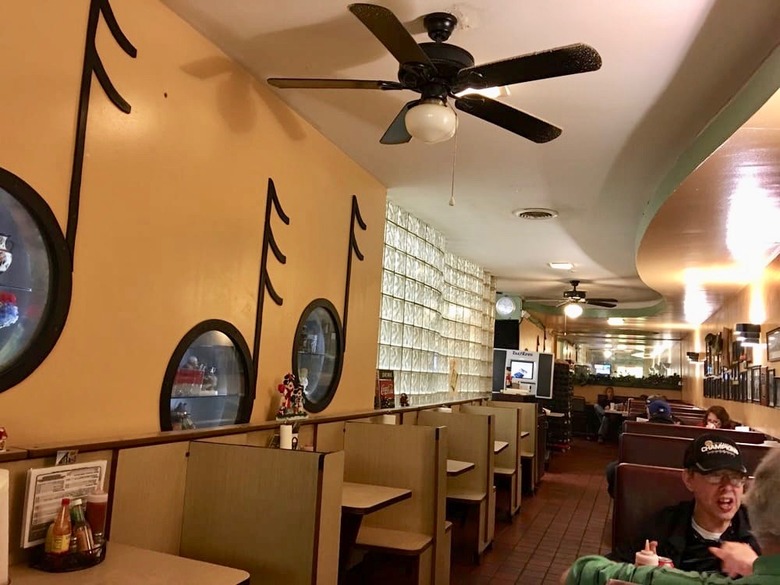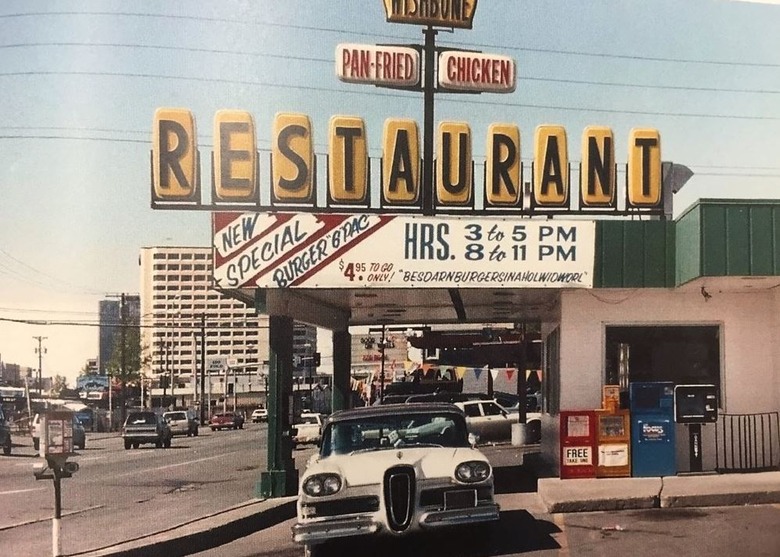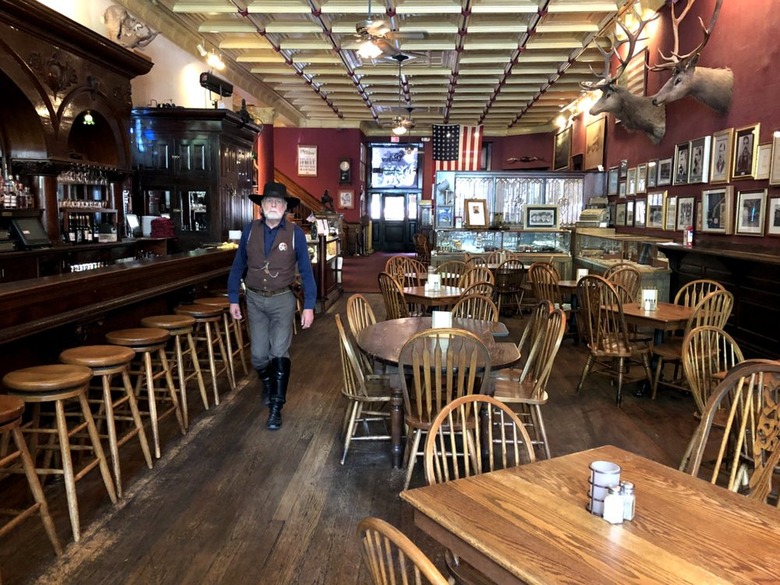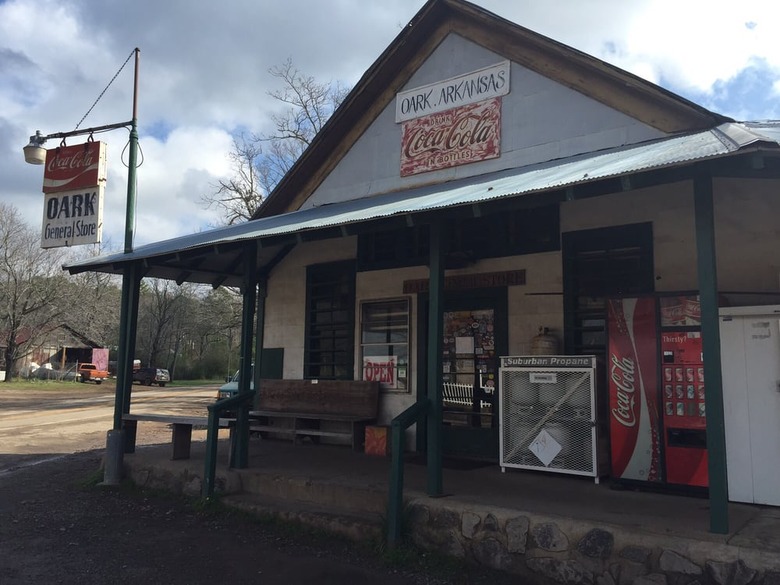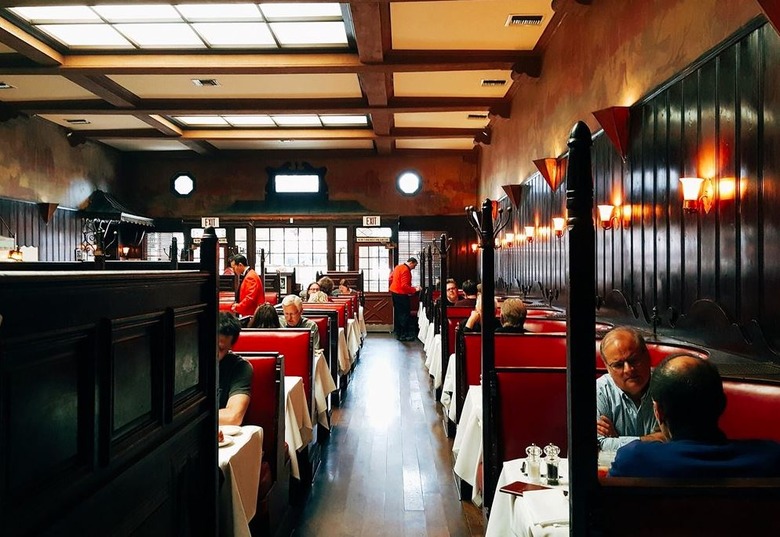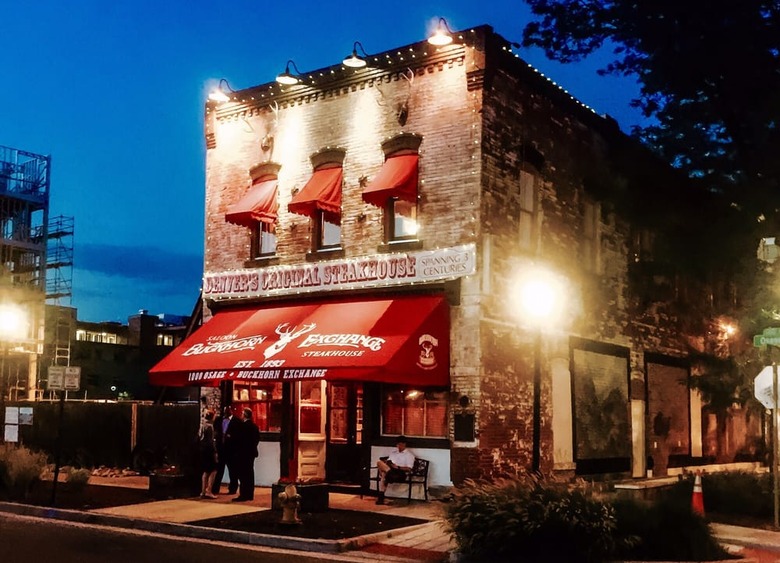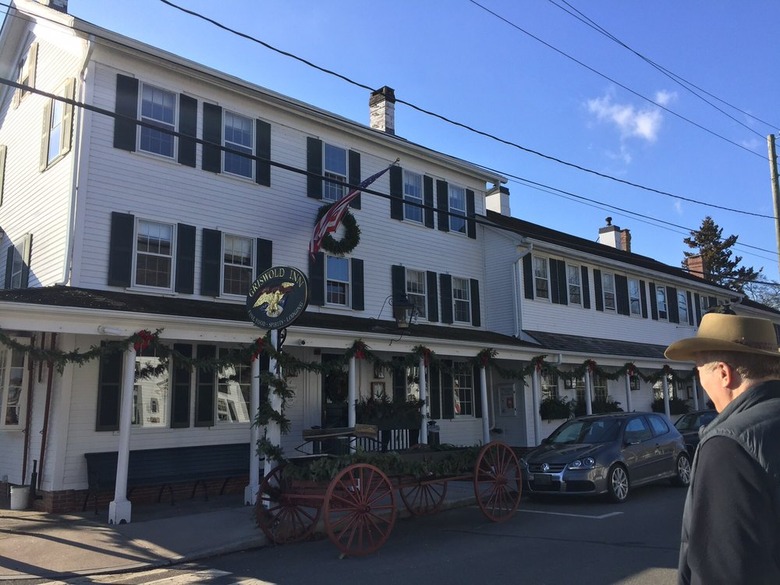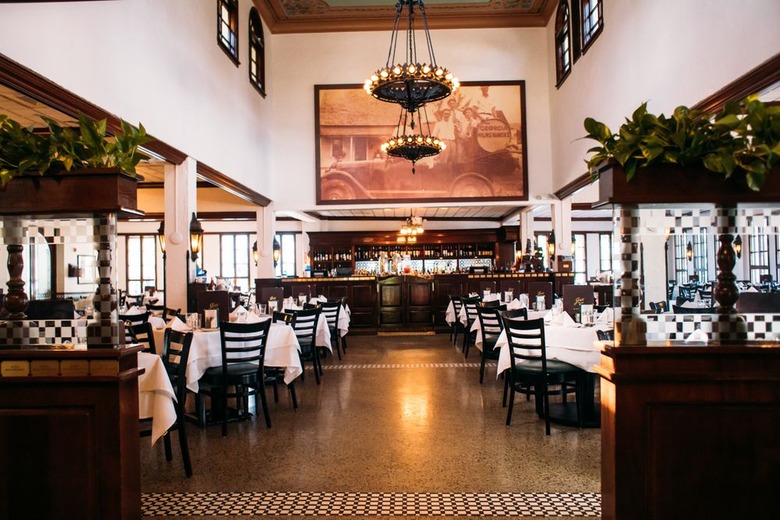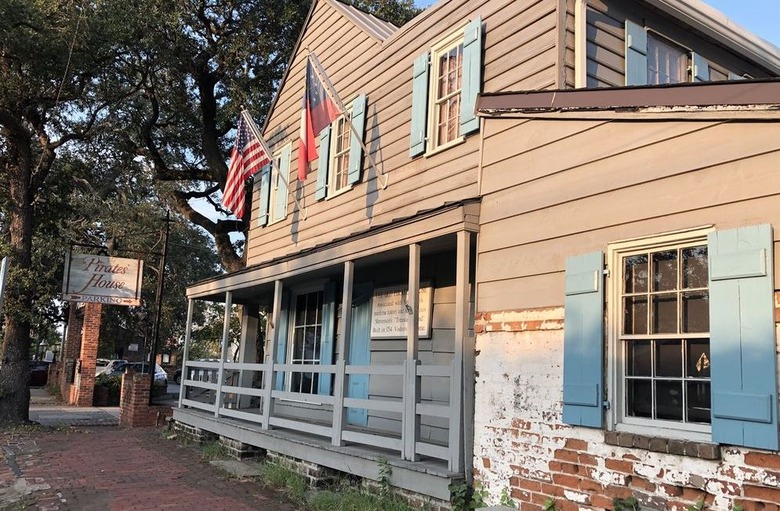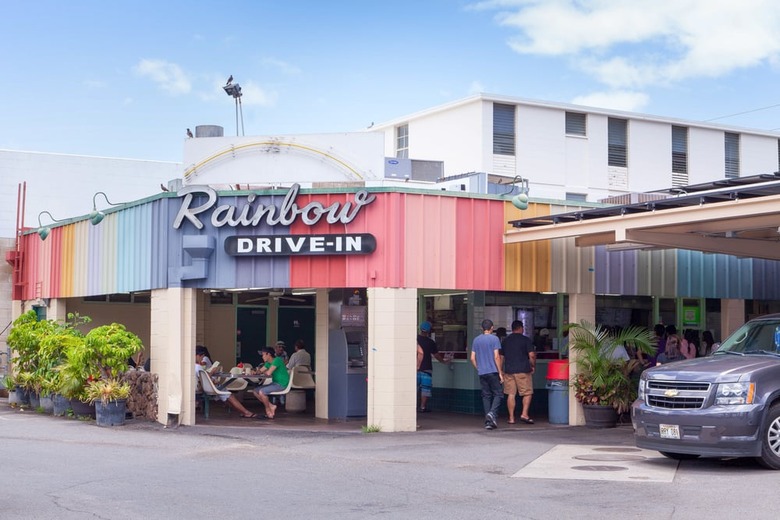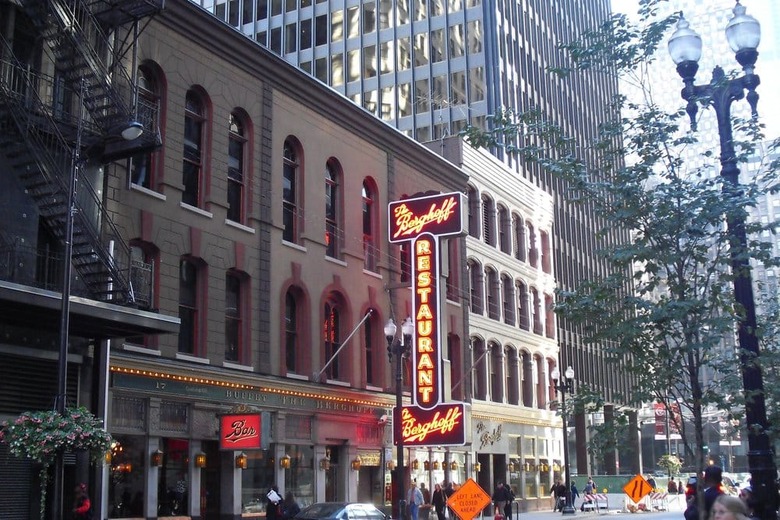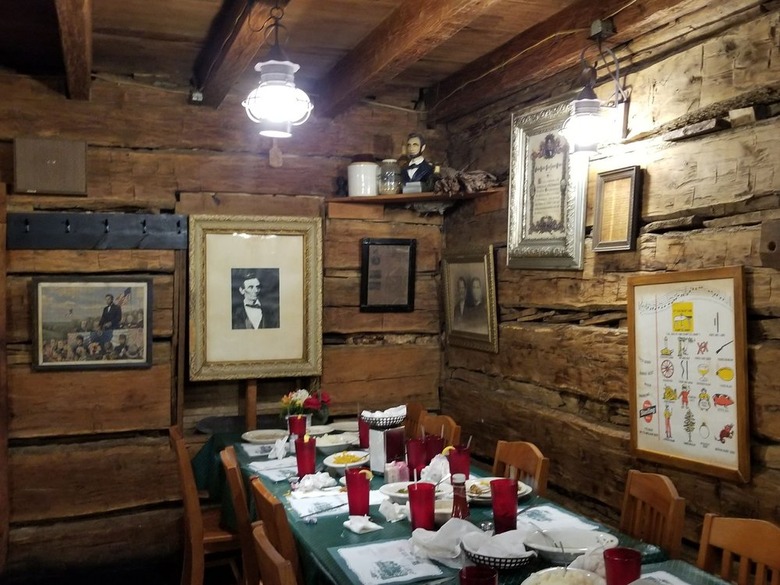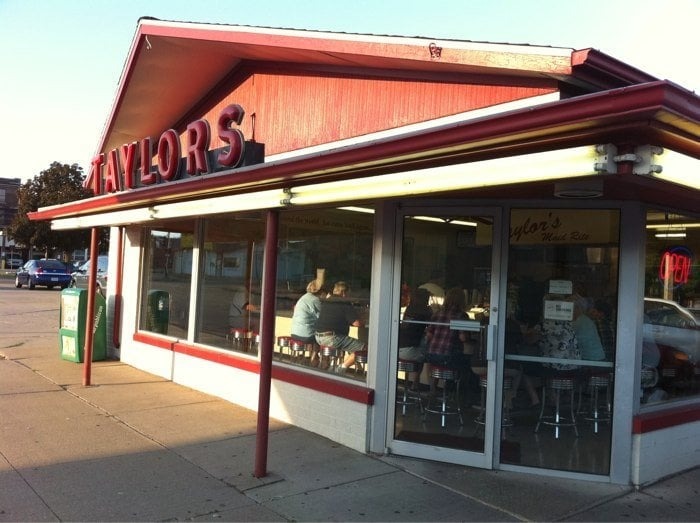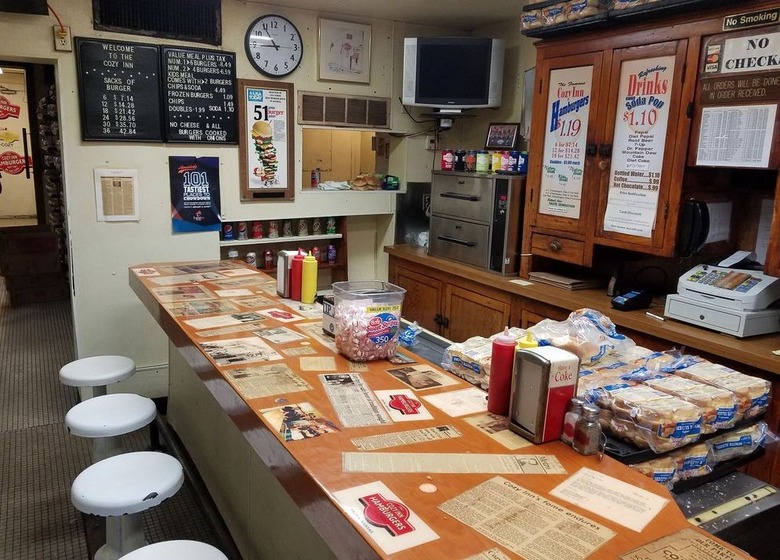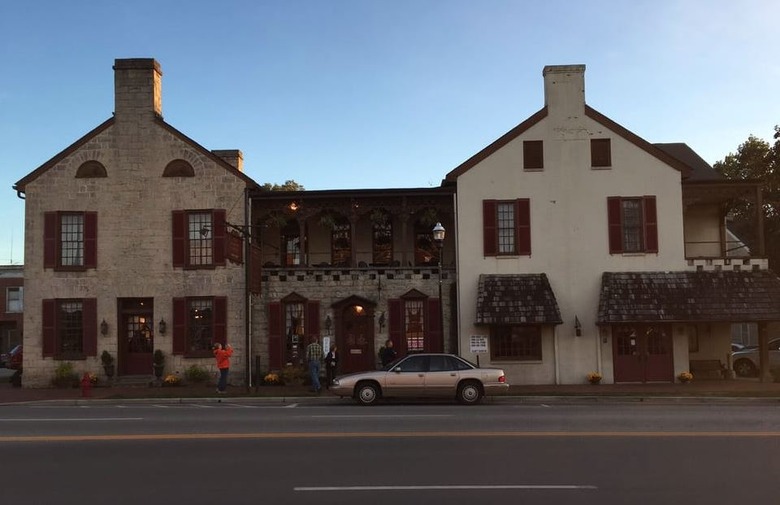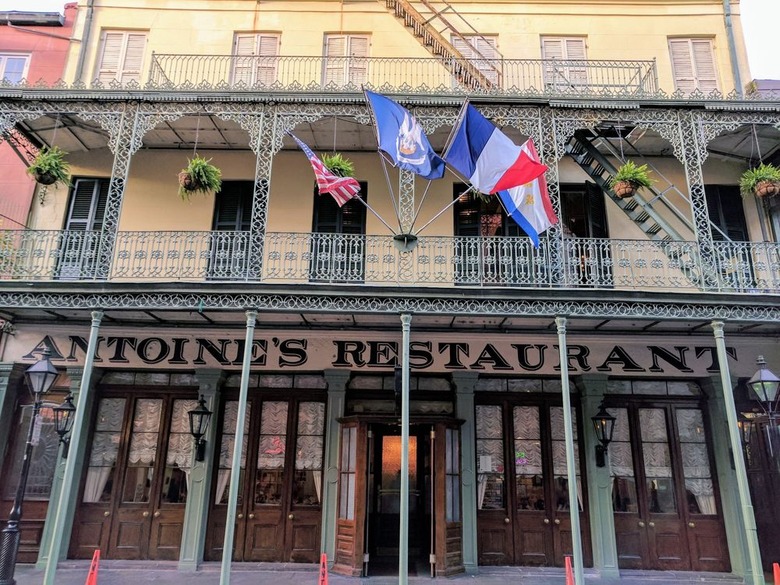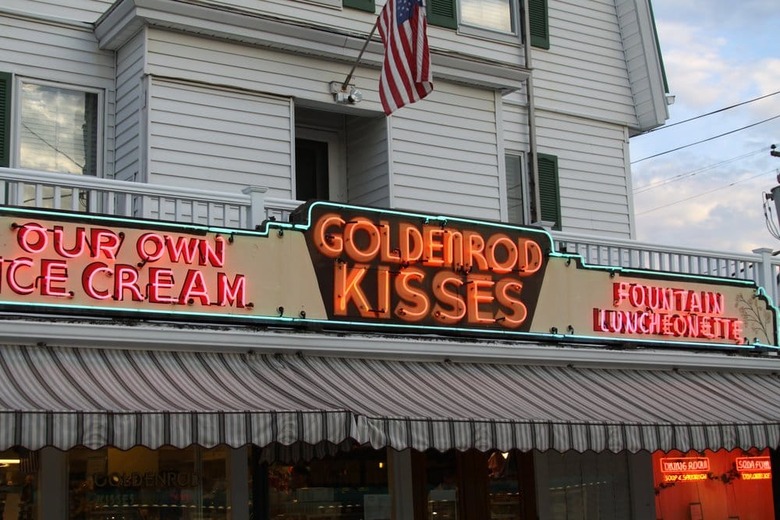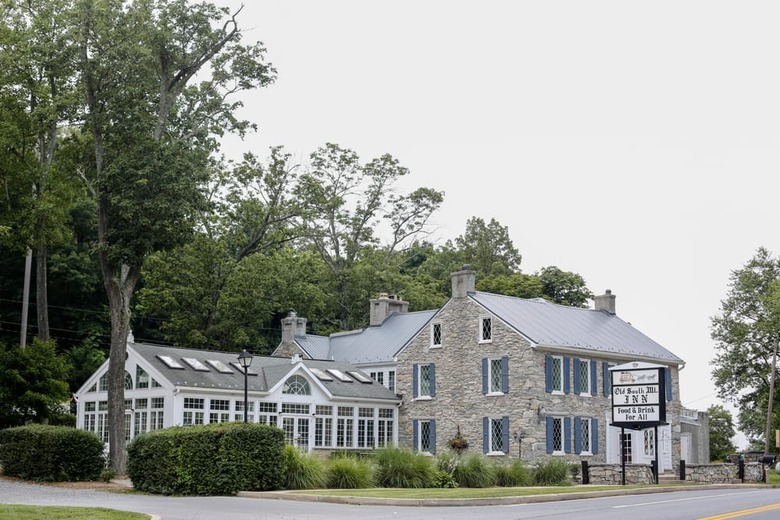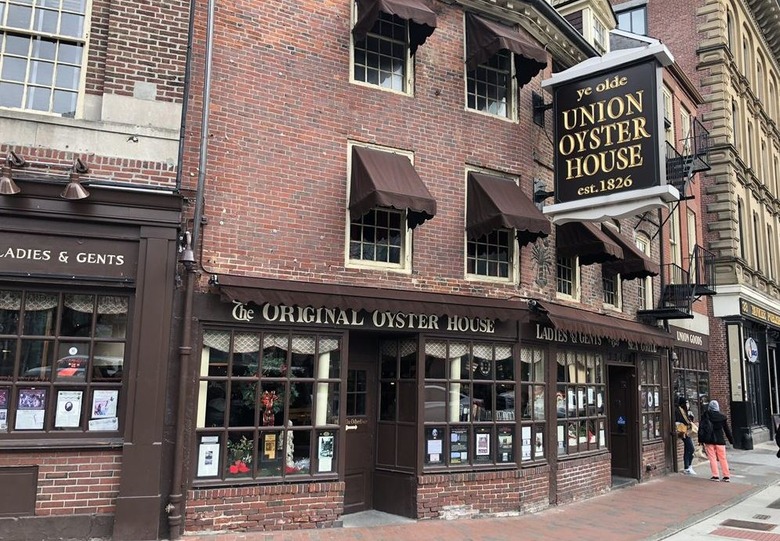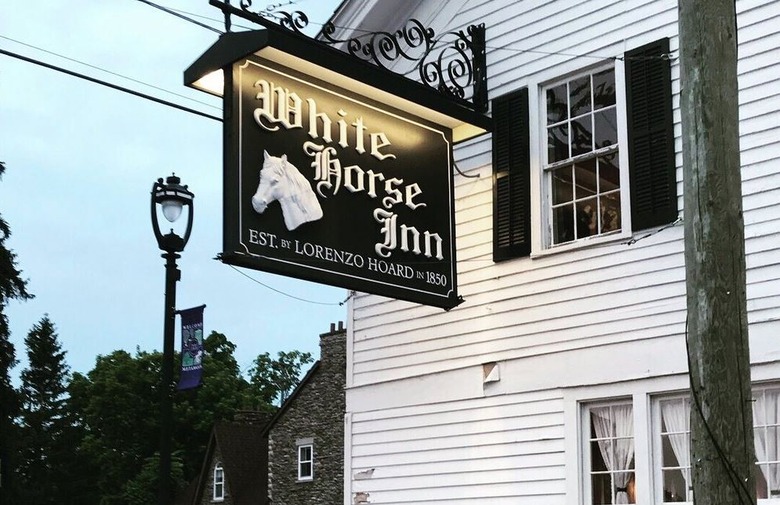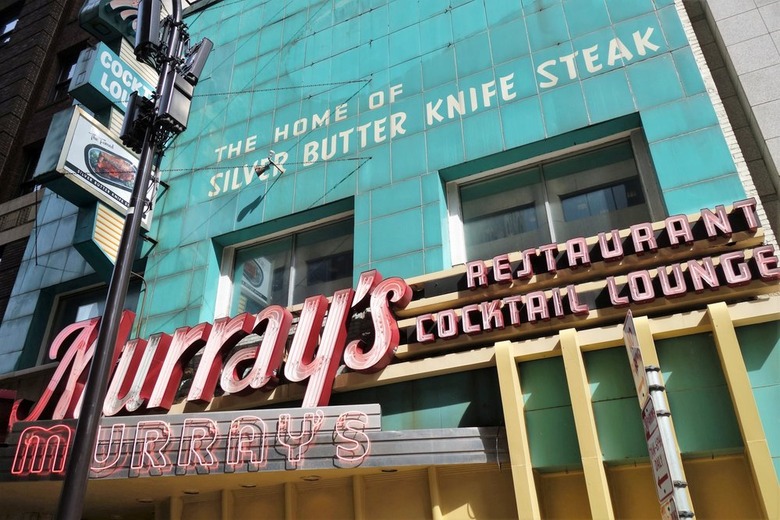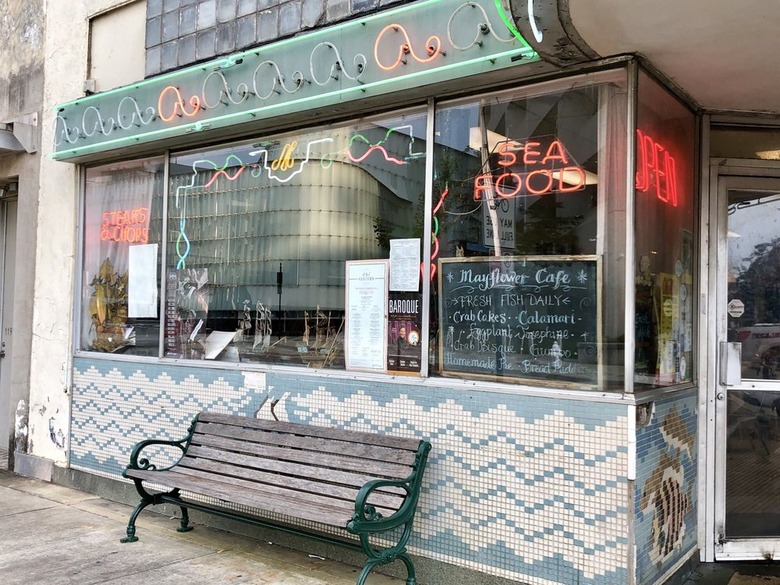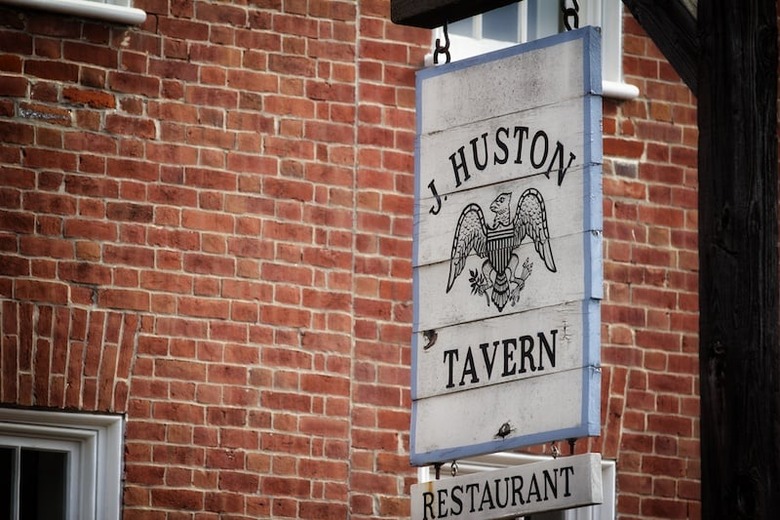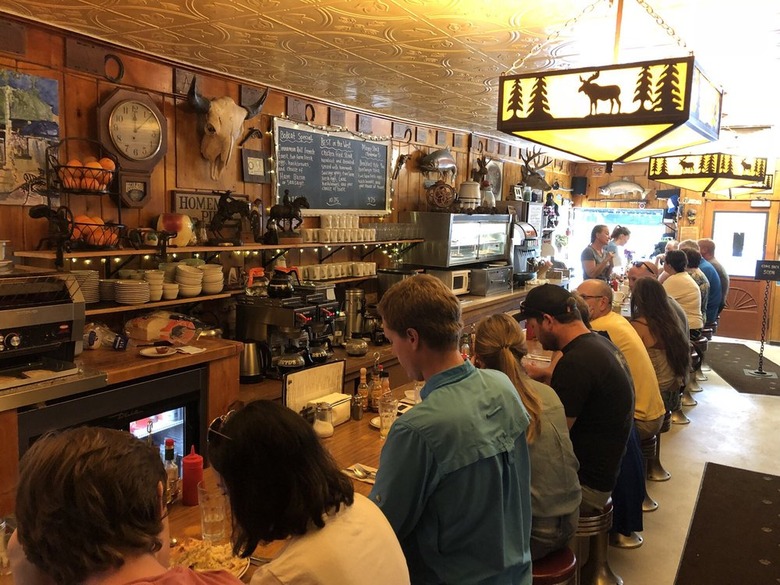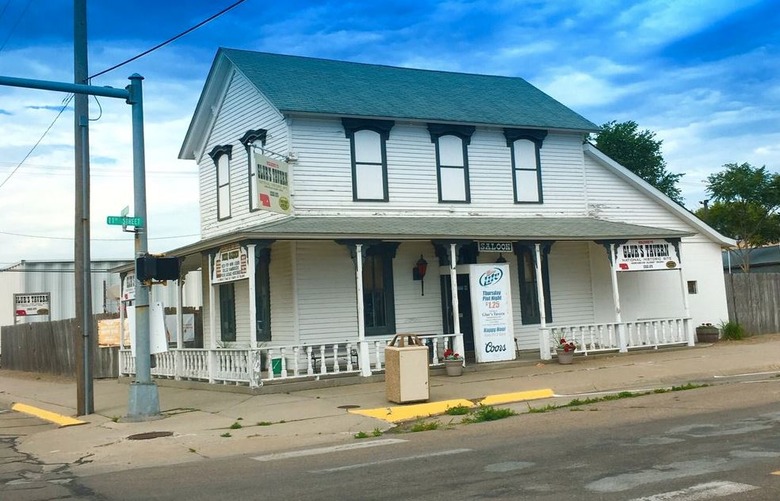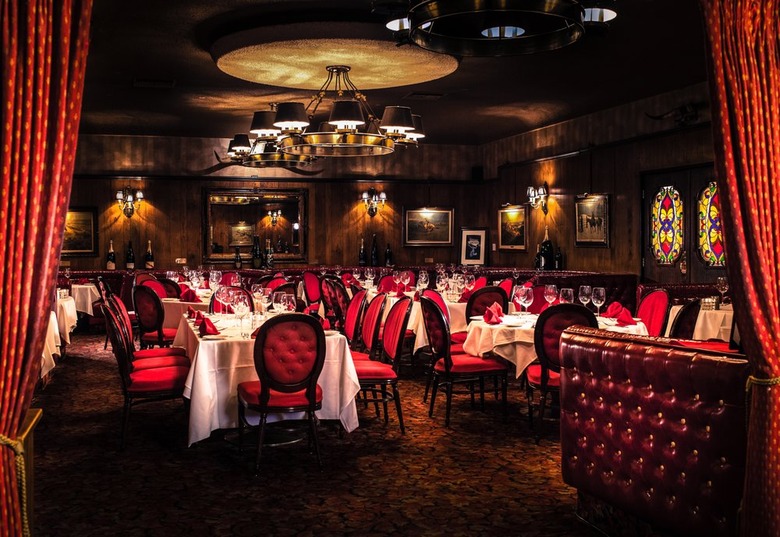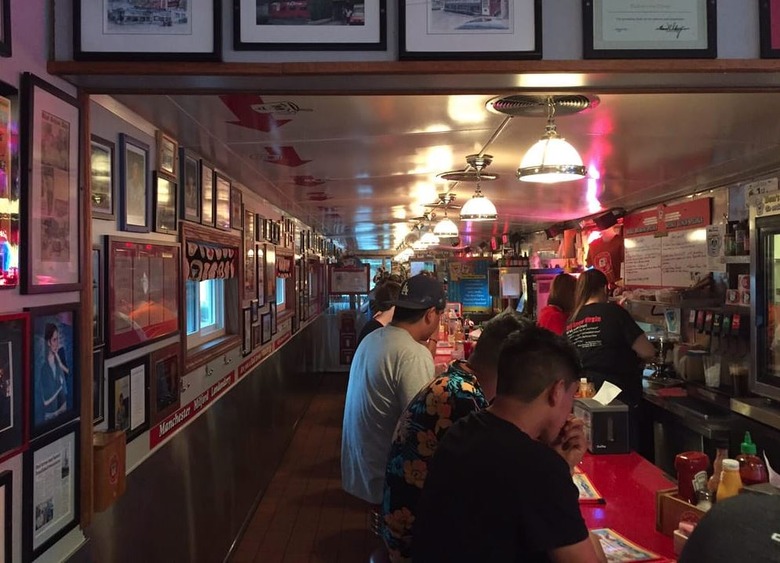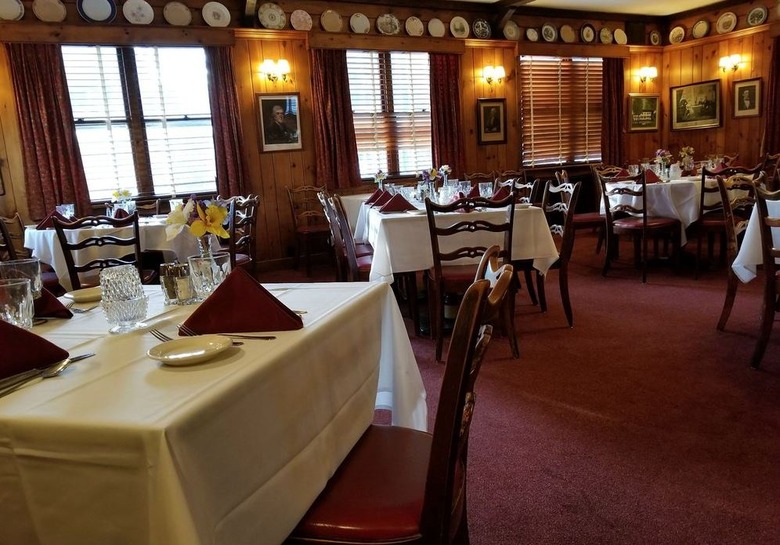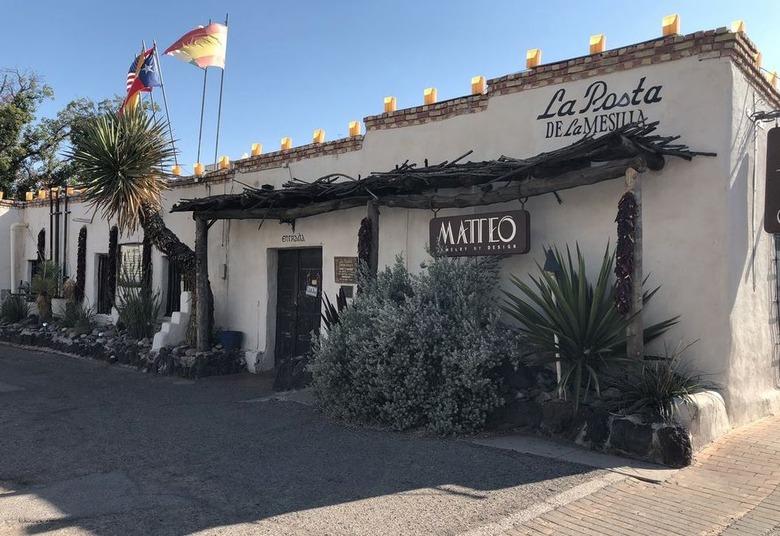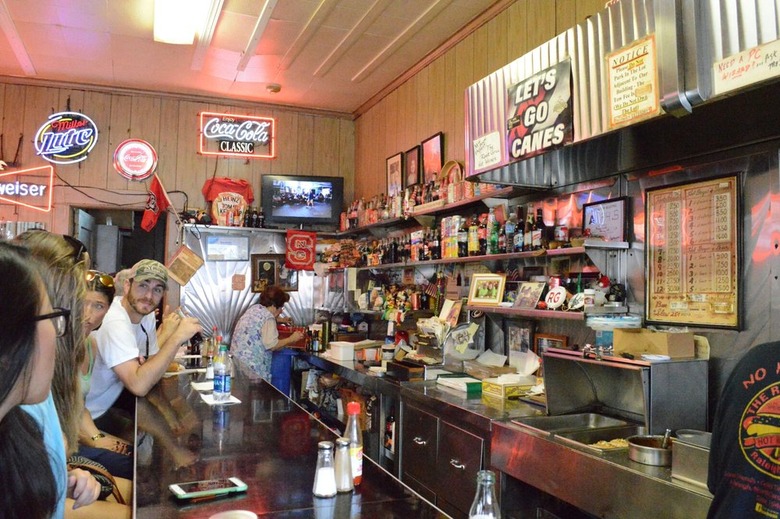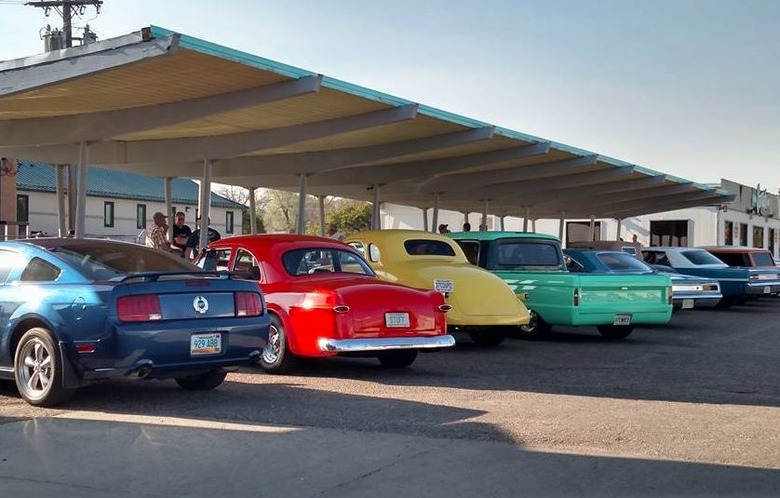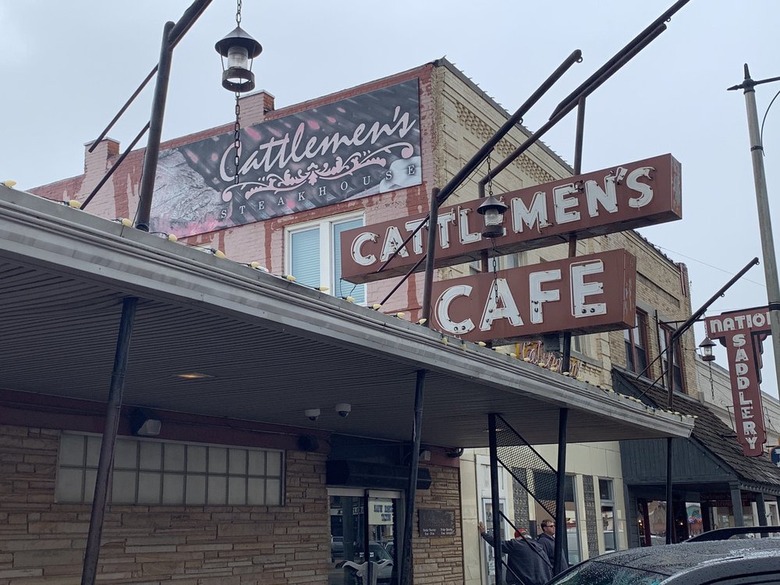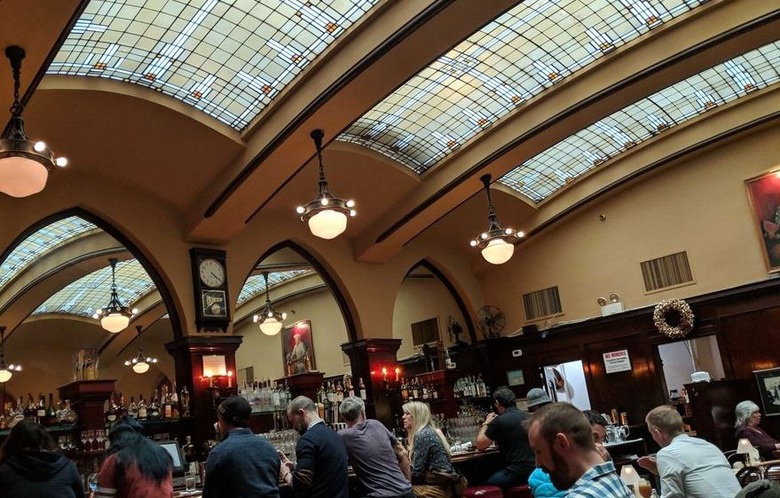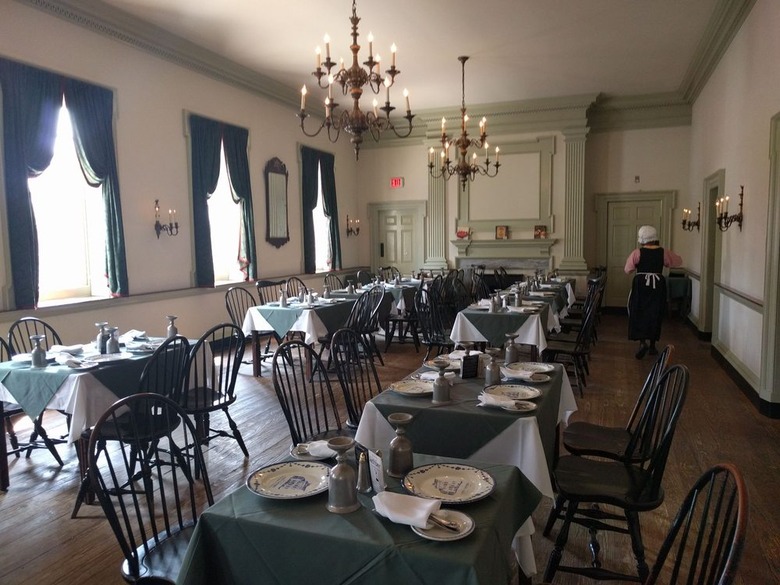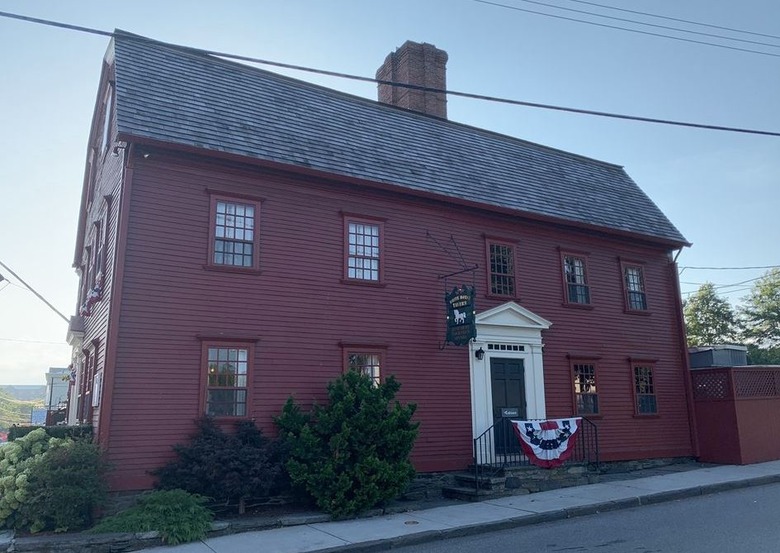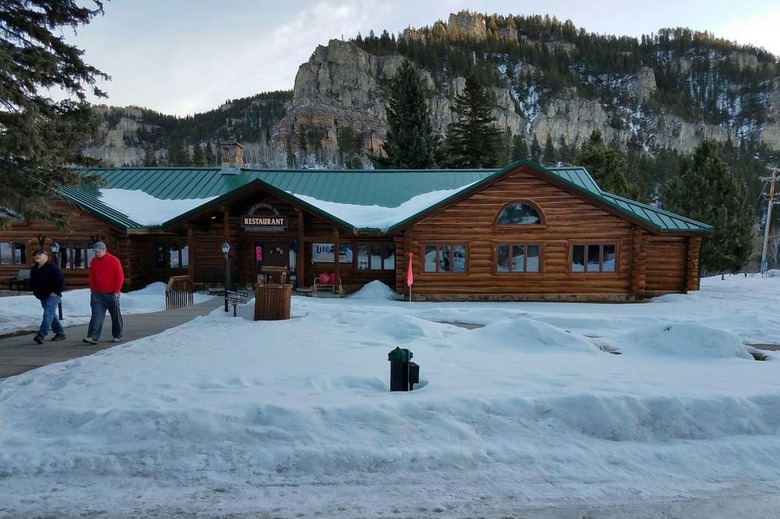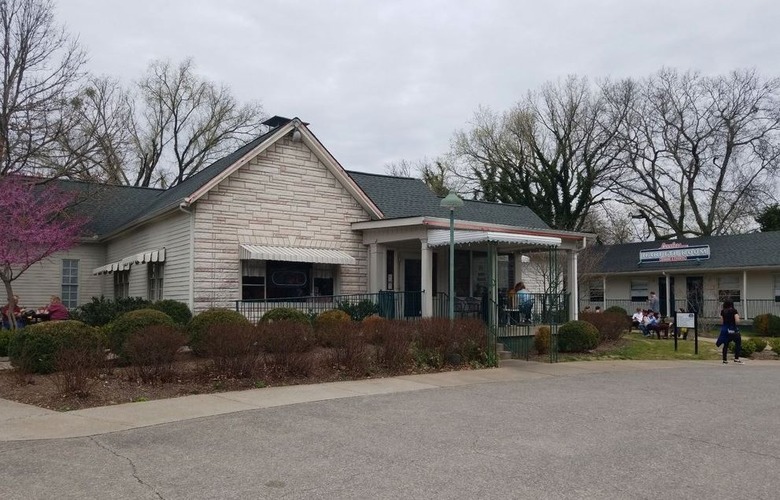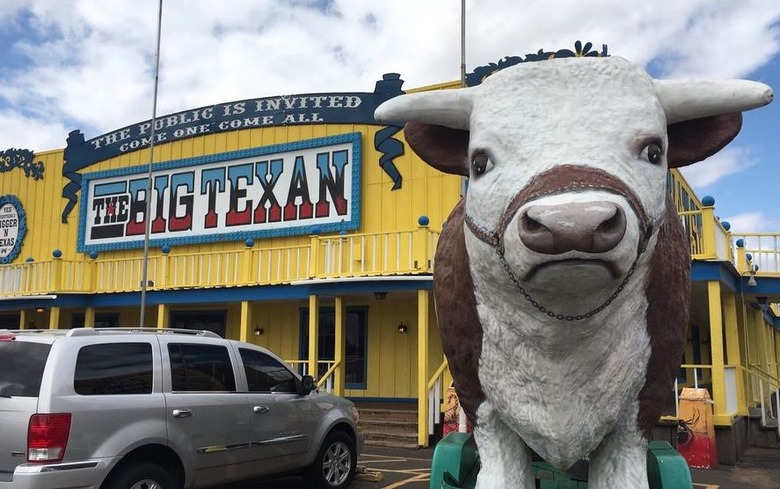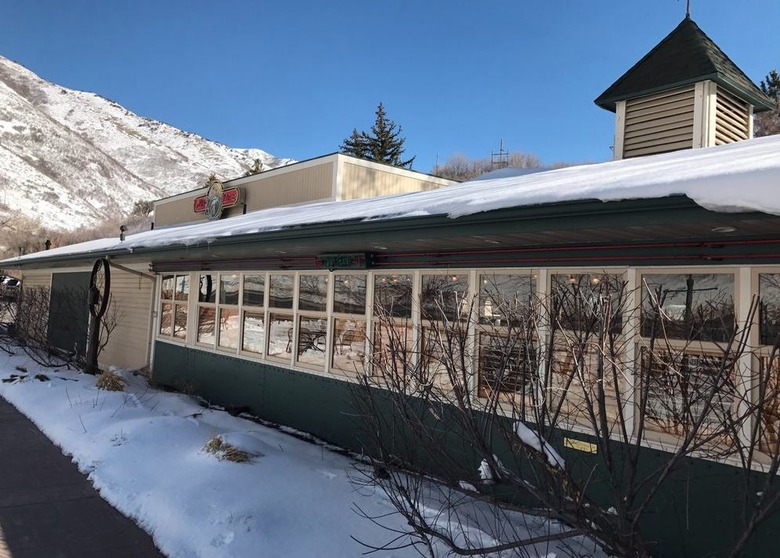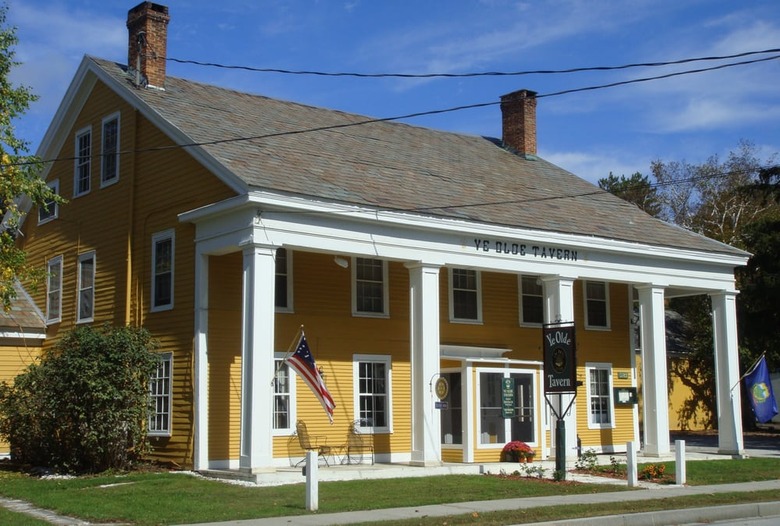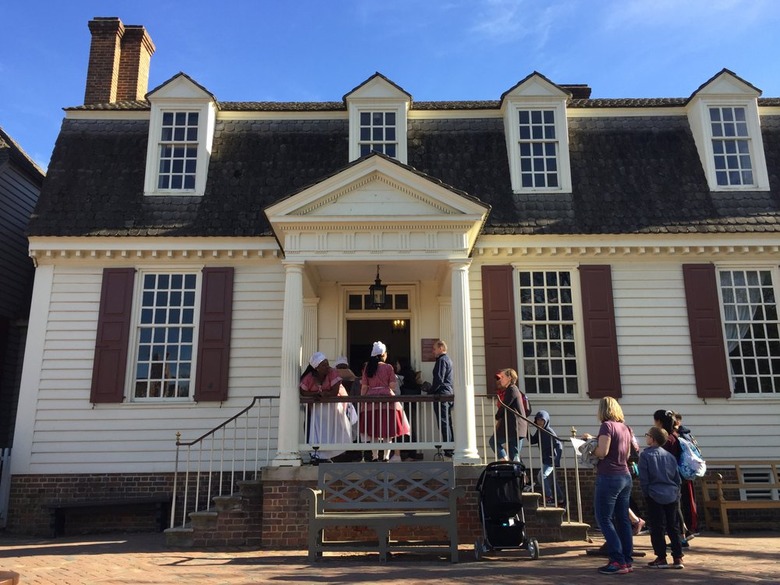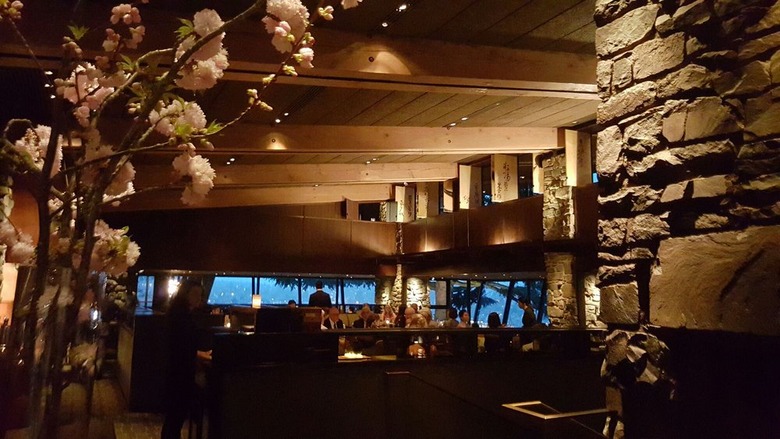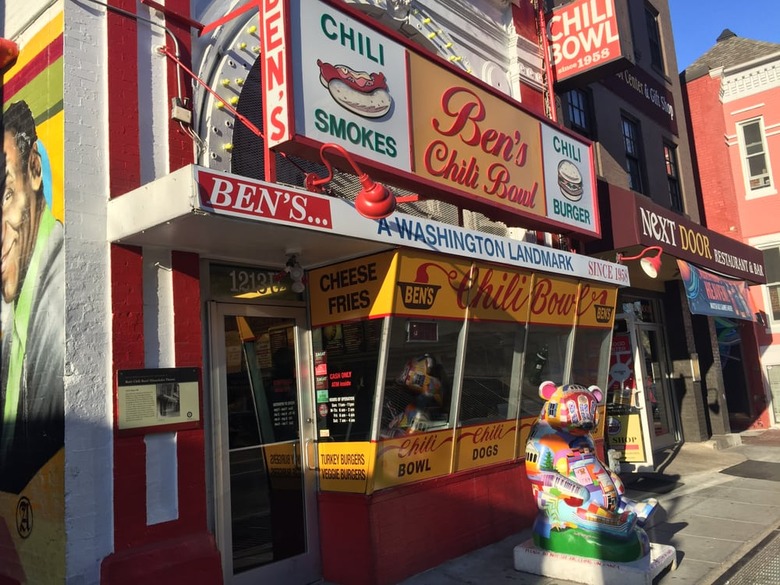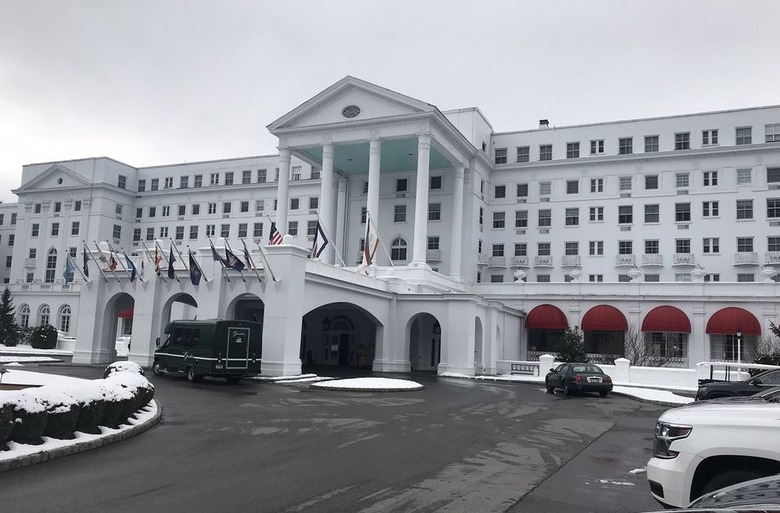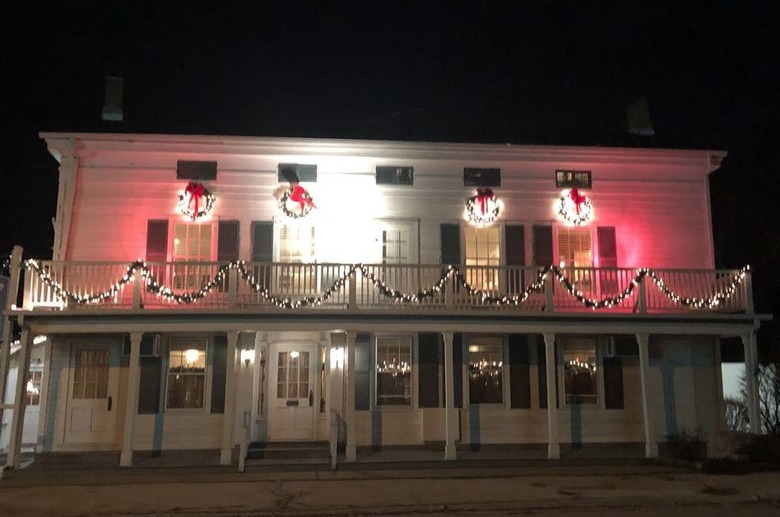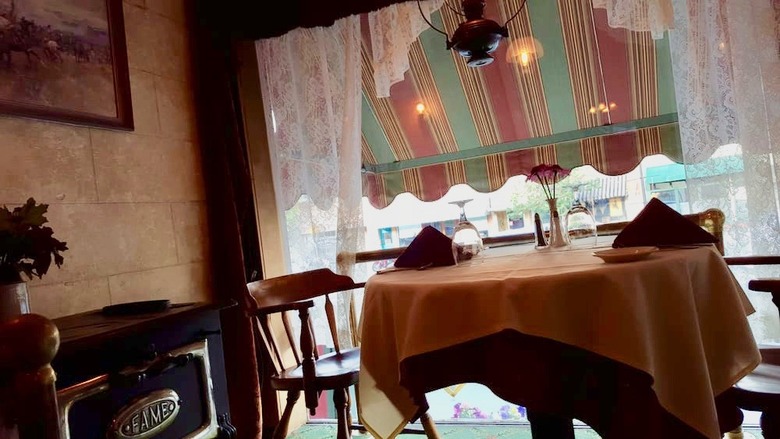The Most Historic Restaurant In Every State
There's a big difference between an old restaurant and a historic restaurant. An old restaurant might have been around for 100 years, but historic restaurants, on the other hand, are ones that feel like they're a part of history, and when you dine there, you feel like you're a part of that history as well. The restaurants on this list haven't just been around for a long time, they've invented now-popular dishes or serve as a snapshot of how we used to eat. They've hosted major figures in American history, serve as time capsules to an earlier era and have undoubtedly played a role in history.
Methodology
In order to assemble our list of the most historic restaurants in every state, we started by consulting our ranking of the oldest restaurant in every state, but then took it a step further and sought out restaurants that have remained unchanged for long periods of time while also telling a story about their town, state or country. Dining at these restaurants is taking a visit to the past, be it the 1750s or the 1950s. Not all of these restaurants saw the likes of Abraham Lincoln (although two of them supposedly did), but each of them has borne witness to history, and if their walls could talk, they'd tell a great tale.
Alabama: Chris’ Hotdogs (Montgomery)
Chris' Hotdogs opened on Montgomery's famed Dexter Avenue in 1917, and it's served guests including Franklin Roosevelt, Harry Truman, Martin Luther King Jr., Elvis Presley, F. Scott and Zelda Fitzgerald and Clark Gable on its way to becoming Montgomery's oldest family-owned-and-operated restaurant. The throwback goes through 10 gallons of its famous chili sauce daily, and only a handful of people know the recipe. Not only is it historic, Chris' is one of America's best hot dog joints.
Alaska: Lucky Wishbone (Anchorage)
Alaska's oldest single family-owned restaurant, Lucky Wishbone was founded by George and Peggy Brown in 1955. The restaurant quickly became well-known for its fried chicken and survived Anchorage's devastating 1964 earthquake. It was the first restaurant in the state to ban smoking in 1991, and when George passed away at age 96 in 2018, it was big news. Though George is no longer there, a visit today will still set you up with some of the tastiest fried chicken in America (never frozen, buttermilk-battered and super-crispy) and plenty of midcentury no-frills charm.
Arizona: The Palace Restaurant and Saloon (Prescott)
An honest-to-goodness Arizona frontier saloon, The Palace opened in 1877 and attracted the likes of Wyatt Earp and Doc Holliday before burning down in 1900 and being rebuilt the following year. Thankfully, the restaurant has been meticulously restored and still has a true Wild West feel to it, right down to stag heads on the wall and the bartenders slinging drinks behind the original 1800s Brunswick bar.
Arkansas: Oark General Store (Oark)
The small Arkansas town of Oark was isolated from the rest of Johnson County when the much-needed Oark General Store opened in 1890 to supply the rural town with groceries and supplies. Today, it's the oldest continually operated store in Arkansas, serving a simple menu of burgers, sandwiches, pies and ice cream. As a nod to its past, you can still stock up on groceries and fill up your gas tank.
California: Musso & Frank Grill (Los Angeles)
In 1919, entrepreneur Frank Toulet opened a restaurant on Hollywood Boulevard, later teaming with restaurateur Joseph Musso. In 1927, the restaurant was purchased by Italian immigrants John Mosso and Joseph Carissimi, who moved it next door a few years later. It's still in that location today, run by Mosso's three granddaughters, and it's seen a ton of Hollywood history in that time. Charlie Chaplin and Douglas Fairbanks reportedly challenged each other to horse races to see who would pick up the tab there, Greta Garbo and Gary Cooper had breakfast together there and other regulars included Marilyn Monroe, Jimmy Stewart and Humphrey Bogart. It remains classy, timeless and sophisticated, and it also holds a special place in culinary lore: It's supposedly the first restaurant outside of Rome to have served fettuccine Alfredo, one of the most popular pasta dishes of all time.
Colorado: The Buckhorn Exchange (Denver)
In November 1893, Zietz's Buckhorn Restaurant (today known as The Buckhorn Exchange) was founded by Henry H. Zietz, also known as "Shorty Scout," a nickname reportedly bestowed upon him by "Buffalo Bill" Cody himself. The restaurant was the first in the state to receive a liquor license, and it's a perfect chronicle of Colorado history, with walls lined with 575 taxidermied animals and 125 guns among other assorted artifacts. Its white oak bar dates to 1857, and it's the one restaurant you absolutely need to visit in the state.
Connecticut: The Griswold Inn (Essex)
The Griswold Inn opened its doors in 1776, making it as old as America itself, but it truly came into its own during the 1820s, when steamboat service began between New York and Hartford with a stop in Essex, and the inn became an essential refuge for travelers. In the 1840s, the Temperance Movement brought protests there (a banner is still hung in the dining room), and it was a popular hangout among yachtsmen in the postwar years. Today, it's a beloved local landmark with a main dining room that's covered wall-to-wall with historic artifacts and marine art, and it still offers a true New England inn experience.
Delaware: Jessop’s Tavern (New Castle)
The building that's currently home to Jessop's Tavern was built in 1674, and while it's served as many different restaurants over the years, the current owners have really gone all-out to preserve its history, with colonial-inspired furniture and art on the walls, a menu with plenty of colonial fare (hello, pot roast and shepherd's pie) and even servers in traditional colonial garb. This isn't some Disneyfied facsimile of "ye olden days," it's a historical snapshot with a great selection of Belgian beers to boot.
Florida: Joe’s Stone Crab (Miami Beach)
In 1913, when Hungarian immigrants Joe Weiss and his wife, Jennie, opened a small lunch counter in Miami Beach, it was the only restaurant on the beach. Collins Avenue was a rutted trail and stone crabs were considered to be inedible. But one day Joe tossed some of their claws into boiling water, realized that they were in fact delicious and the rest is history. The restaurant (and its popularity) grew throughout the 20s and 30s, and it soon became a must-visit for luminaries passing through town, hosting the likes of Will Rogers, Amelia Earhart, J. Edgar Hoover and Damon Runyon in its early days. Today, it's still owned by the Weiss family and it's still serving legendary stone crab claws, one of the 101 most iconic restaurant dishes in America.
Georgia: The Pirates’ House (Savannah)
The Pirates' House was constructed around 1753 on the site of America's first public experimental agricultural garden. Given that it's located just a block from the Savannah River, it quickly became a popular inn for sailors and, yes, pirates who happened to be passing through town. Saved from demolition after World War II, it was faithfully restored to its former glory and became a tea room in 1953. Today, it's a touristy restaurant that the locals still love, serving classic Lowcountry fare in dim, rustic, low-ceilinged digs.
Hawaii: Rainbow Drive-In (Honolulu)
Rainbow Drive-In was founded by Okinawa-raised Seiju Ifuku in 1961 and quickly became popular for serving hearty portions of filling fare like chili and rice, burgers and barbecue beef to local workers and Waikiki beachgoers. The restaurant and its menu of traditional Hawaiian plate lunches (one of the best things to eat in America, by the way) gained more and more popularity over the years, and today it's still serving those same hearty dishes in the original space. It's also still family-run, providing locals and tourists with a true taste of blue-collar Hawaii.
Idaho: The Snake Pit (Enaville)
In 1879, Enaville, Idaho, was a railroad changeover and major transportation hub for miners and loggers, and that's the year that The Snake Pit opened. It served as a bar, hotel and brothel in its early years. Now it's an eclectic and rustic Silver Valley bar and restaurant that serves hearty breakfasts, burgers, steaks and barbecue in a dining room filled with handcrafted wooden furniture, a massive stone fireplace and plenty of local art and memorabilia on the walls.
Illinois: The Berghoff (Chicago)
Herman Berghoff emigrated from Germany to Chicago in 1870 and opened his restaurant, The Berghoff, in 1898. Back then a beer cost a nickel and came with a free sandwich, and the restaurant was able to survive throughout Prohibition by serving "near beer." After Prohibition ended, The Berghoff received the city's first liquor license, and only permitted men until activists including Gloria Steinem ended the segregation in 1969. Today it's a Chicago landmark, one of the country's top spots for traditional German fare, and one of America's greatest old-school restaurants.
Indiana: The Log Inn (Haubstadt)
Originally constructed as a stagecoach stop and trading post in 1825, The Log Inn prides itself on the fact that Abraham Lincoln stopped there in 1844 while campaigning for Henry Clay, and during the Civil War it served as a stop on the Underground Railroad. Today, it's the oldest restaurant in Indiana with ancient wood beams in the walls and ceiling, and its family-style dinners include some of the best fried chicken in America.
Iowa: Taylor’s Maid-Rite (Marshalltown)
The Maid-Rite is a beloved regional specialty thanks to Fred Angell, who opened the first location of Maid-Rite in Muscatine, Iowa, in 1926 and soon franchised the concept. Cliff Taylor purchased a franchise in Marshalltown in 1928, which his son Don took over after he passed away and moved into high-tech (for the time) new digs in 1958. This is where the location remains today. Today there are Maid-Rite locations throughout Iowa and the Midwest. This is a regional chain that should go national, but the Marshalltown location operates independently of the others and appears frozen in time while serving the iconic loose meat creation made by piling finely ground hamburger meat onto a bun and topping it with mustard, ketchup, pickles and/or chopped onions.
Kansas: Cozy Inn (Salina)
In the 1920s, as the concept of "fast food" began to catch on, a slew of White Castle-inspired restaurants sprung up across the country to serve tiny burgers. Cozy Inn, which opened in Salina, Kansas, in 1922, is one of the few that remain. The six-stool diner served tiny, oniony burgers for five cents a pop, and its popularity grew during the Depression and again during World War II when military bases opened nearby. Aside from the addition of some outdoor seating, not much has changed since the early days, so taking a seat at one of its six stools can teleport you to an earlier time. The sliders served here have since jumped in price to a whopping $1.19, but are among the best burgers in America.
Kentucky: The Old Talbott Tavern (Bardstown)
Built as a stagecoach stop in 1779, the Talbott Tavern provided food and lodging to America's early pioneers, and over the years it racked up a major amount of historic moments. Abraham Lincoln stayed here as a child, Andrew Jackson warmed up by the hearth, a member of King Louis Philippe's entourage is believed to have painted murals on the walls (which were uncovered in 1927) and Jesse James may have shot some holes in a wall after too many drinks in the pub. Oh, and it's probably haunted. All these years later, it's still providing a hot meal and a bed to folks passing through town.
Louisiana: Antoine’s Restaurant (New Orleans)
At 18 years old, Antoine Alciatore opened up a restaurant and boarding house in 1840, and Antoine's, which moved into its current location in 1868, is now the oldest family-operated restaurant in the country. Its elegant dining rooms have entertained everyone from Bob Hope and Bing Crosby to Franklin Roosevelt and Bill Clinton over the years, and it remains one of New Orleans' quintessential Creole restaurants. If you visit, be sure to order Oysters Rockefeller, which was invented there.
Maine: The Goldenrod (York Beach)
Since 1896, crowds have lined up along York Beach to watch the production of the famous "Goldenrod Kisses" (known elsewhere as saltwater taffy) through the front windows of The Goldenrod, a seasonal restaurant, soda fountain and candy shop. Drop by the restaurant for classic breakfast fare, sandwiches and some of the best lobster rolls in Maine, take a seat at the soda fountain for a hot fudge sundae made with homemade ice cream and pick up some candy for as little as 2 cents.
Maryland: The Old South Mountain Inn (Boonsboro)
It's believed that the Old South Mountain Inn was founded as far back as 1732, and it's seen some serious history from its perch atop Turner's Gap. George Washington may have marched by it in 1755 during the French and Indian War, and it served as a stagecoach stop for pioneers in the early 1800s. Daniel Webster and Henry Clay were known to visit and both the John Brown raid on Harper's Ferry and the Battle of Antietam took place nearby during the Civil War. Today, it's an elegant and homey restaurant that's been beautifully restored and serves classic local-inspired fare like crab cakes and rockfish Chesapeake as well as a lavish Sunday brunch.
Massachusetts: Union Oyster House (Boston)
The Union Oyster House first opened for business in 1826, but its building dates back even further — it was home to a dress goods business in 1742 and a newspaper was published on its top floor in 1771. Daniel Webster would stop by for oysters and brandy daily, the toothpick made its American debut there and it was a favorite haunt of the Kennedy clan; JFK's favorite booth is marked with a plaque. The Union Oyster House has had only three owners over the years, and its interior is a rustic and cozy time capsule of Boston history.
Michigan: The White Horse Inn (Metamora)
Established as a stagecoach stop and inn in 1850, The White Horse Inn originally charged 50 cents for a night's lodging and was a popular stop for those traveling on the Michigan Central Railroad, which ran right through town. It remained a boarding house and restaurant for decades, and after years of neglect, it was purchased by the husband-and-wife duo of Victor Dzenowagis and Linda Egeland in 1912 and completely renovated and restored. Today, every element of the equestrian-themed restaurant is a thoughtful nod to the past, and the menu is full of Midwestern comfort foods including ribs, potato chip-crusted walleye, pot roast and chicken pot pie.
Minnesota: Murray’s Steakhouse (Minneapolis)
Art and Marie Murray opened Murray's Steakhouse in 1946, and it soon became a must-visit for Minneapolis' hoi polloi. Art and Marie were gracious hosts, attracting legions of regulars who turned it into one of the city's most popular restaurants. It remains a timeless classic and one of America's best steakhouses to this day. Many signature menu items including garlic toast, pretzels, pies and its famed Silver Butter Knife Steak — a 28-ounce strip sirloin carved tableside — are still served. Three of Art and Marie's grandchildren are currently on the management team.
Mississippi: Mayflower Cafe (Jackson)
Jackson's oldest operating restaurant opened in 1935 and is still serving a menu of classic Greek-inspired seafood and steaks. Its house dressing, a creamy amalgam of condiments now locally known as comeback sauce, is legendary and available for purchase by the bottle.
Missouri: J. Huston Tavern (Arrow Rock)
Built as a private home by settler Joseph Huston in 1834, what became the J. Huston Tavern was soon converted into a boarding house and stopover for the hordes who passed by on their journey west. A mercantile store and ballroom were added over the course of the following decades, and a large dining room and modern kitchen were added in 1955. There are now three dining rooms and the store has been converted into a great bar, and museum spaces provide a glimpse into pioneer life in the 1800s.
Montana: Western Cafe (Bozeman)
The Western Cafe's website proudly proclaims that it's "been in the Bozeman community for the better part of a century," and it still looks the part. The narrow lunch counter and restaurant is covered in light wood paneling and the menu is chock-full of simple, down-home scratch-made fare like biscuits and gravy, homemade cinnamon rolls, burgers, chicken fried steak and open-faced roast beef sandwiches. Be sure to get a slice of pie for dessert.
Nebraska: Glur’s Tavern (Columbus)
The oldest continually operating tavern west of the Mississippi, Glur's opened in 1876 as the Bucher Saloon and was a favorite hangout of Buffalo Bill while he was rehearsing his Wild West show nearby. While the interior may have more of a 1970s rec room vibe these days, there's still an old "saloon" sign swinging over the front door, and it's even earned itself a spot on the National Register of Historic Places.
Nevada: Golden Steer Steakhouse (Las Vegas)
A true Las Vegas relic, The Golden Steer has been one of the best steakhouses in the country since it first opened its doors in 1958. It had a front-row seat to Vegas' Golden Age, hosting the likes of Elvis, the Rat Pack and Joe DiMaggio. It's been faithfully restored to reflect the glitz and glamor of its early days.
New Hampshire: Red Arrow Diner (Manchester)
The Red Arrow opened in Manchester in 1922 and since that time it's changed very little and has achieved a level of national renown that even the owners are hard-pressed to explain. Photos of all its celebrity visitors line the walls (Paul Newman and RuPaul have dropped by, and Adam Sandler, who grew up in Manchester, is something of a regular), but if it has one claim to fame, it's its association with the New Hampshire Primary. It's become a must-visit for politicians on the campaign trail, a place to connect with the locals. This is a true old-school hangout, and one of the best 24-hour diners in America.
New Jersey: The Cranbury Inn (Cranbury)
The Cranbury Inn got its start as two taverns constructed in 1750 and 1765 that were later combined and joined by a barn, a telegraph office, a justice of the peace office, an innkeeper's house, a dance pavilion and a main dining room. Visit today and you'll find a charming Colonial-inspired complex with a banquet hall, a bar, a liquor store and multiple dining rooms serving upscale fare and a fancy Sunday brunch. Its history is undeniable. George Washington's troops camped nearby, it may have served as a stop on the Underground Railroad, and famous visitors include Albert Einstein, who was friends with the owner.
New Mexico: La Posta de Mesilla (Mesilla)
The compound that La Posta de Mesilla is a part of was constructed in the 1840s, and after the Civil War, it became an important stop on the Butterfield Stagecoach Line. The restaurant itself opened here in 1939, and since then it's grown to incorporate more than 17,000 square feet of the compound and includes private dining rooms, two cantinas, shops and a courtyard. It offers a true taste of New Mexican cuisine and is an ideal place to try both red and green regional chili styles, carne adovada and flan.
New York: Delmonico’s (New York)
Few restaurants have a more storied history than New York's Delmonico's, which is widely regarded as America's first fine-dining establishment. In 1837, when brothers Giovanni (John) and Pietro (Peter) Delmonico opened their restaurant in downtown Manhattan, the closest things to a "restaurant" you could find were oyster cellars, coffee houses and taverns, and the wealthy tended to dine at home. Now, suddenly, there was an elegantly appointed full-on French restaurant with private dining rooms, a 1,000-bottle wine cellar and produce grown on Delmonico's very own farm. Additional locations soon opened, renowned chef Charles Ranhofer was brought on and introduced new dishes including baked Alaska and lobster Newburg, and the wealthy flocked in droves, with regulars including Mark Twain, Diamond Jim Brady and Charles Dickens. That air of elegance and luxury still can be found at Delmonico's, which is today best known for being one of the city's best steakhouses; order the signature Delmonico steak, a boneless rib-eye that was invented there and can now be found on menus nationwide.
North Carolina: The Roast Grill (Raleigh)
Downtown Raleigh's Roast Grill takes pride in how little it's changed over the years. It still serves one of the best hot dogs you'll find anywhere (topped with only mustard, slaw and/or homemade chili and charred on the original grill) and glass-bottled sodas, as it has since it first opened in 1940. Should you visit this old-fashioned lunch counter nowadays, whatever you do, don't even think about ordering your hot dog with ketchup. Run by George Poniros, who inherited it from his grandmother, the Roast Grill is a true slice of old Raleigh and remains a reflection of the hard work of the city's many Greek immigrants in the early 20th century.
North Dakota: Scotty’s Drive-In (Bismarck)
There are only a handful of honest-to-goodness drive-ins left in America, but Scotty's in Bismarck, which opened in 1964, is keeping the tradition alive. Pull up and place your order for a burger, fries, sloppy Joe, grilled cheese, chili or onion rings and you'll receive the same food as generations before you, and if you choose to dine indoors (indoor seating was added in 1985) you'll discover a polished retro vibe thanks to a 2012 remodel.
Ohio: The Golden Lamb (Lebanon)
Largely thanks to its prime location halfway between Cincinnati and what was then called the National Road (now Route 40), The Golden Lamb has been a popular gathering spot for travelers and locals since New Jersey native Jonas Seaman first opened its doors in 1803. Ohio's longest continually operating business, it got its start as a two-story log cabin, which was soon replaced by a brick structure and became a popular stagecoach stop. It was home to the town's first theater and hotel, hosted everyone from Charles Dickens to Daniel Webster and has been owned by the same family since 1926. When you visit, be sure to check out the period rooms, which are full of Shaker furniture and rare artifacts.
Oklahoma: Cattlemen’s Steakhouse (Oklahoma City)
Oklahoma's oldest continually operating restaurant, Cattlemen's opened in Oklahoma City's Stockyards City area in 1910 and quickly became popular with cowboys and ranchers working and living in the area. Its popularity continued to grow in later years, as it was the only restaurant that remained open after sundown and flaunted Prohibition laws during the 1920s. The restaurant has expanded over the years, but the main "cafe" section remains essentially unchanged since the early days. Do yourself a favor and order the T-bone — it's even available on the breakfast menu.
Oregon: Huber’s Café (Portland)
Founded as a small saloon in 1879 and moved into its current location in 1910, Huber's got its start as the kind of place where a whiskey came with a free turkey sandwich and coleslaw. By the 1940s, the menu had expanded to include steaks, seafood and salads (no longer free of charge, sadly). Its signature drink — Spanish Coffee, prepared tableside with Bacardi 151 rum, triple sec, Kahlua, coffee, whipped cream and nutmeg — was invented in the 1970s and is largely the reason why Huber's is the largest user of Kahlua in the U.S. among independent restaurants today.
Pennsylvania: City Tavern (Philadelphia)
First things first: City Tavern is not in its original structure. The current restaurant was constructed in 1976, but it's such a faithful representation of the original 1773 building and every element of the experience is so steeped in history that it still fits the historic bill. Located just a stone's throw from Independence Hall, the former building (which in Colonial times had a barroom, two coffee rooms, three dining rooms and a ballroom) saw much history over the years. Paul Revere announced the closing of the port of Boston in 1774, it served as a meeting place for delegates of the First Continental Congress, America's first Fourth of July celebration was held there in 1777 and it hosted banquets for George Washington. The structure was razed following an 1834 fire, but visit the new spot today and you'll see history is alive and well. The elegant restaurant, as well as its fixtures and furnishings, appear plucked straight out of the 1770s, and its menu, from chef and Colonial food expert and cooking show host Walter Staib, is heavily influenced from the customs and foods of Colonial America. This eatery should be on the list of places to visit for any American history buff.
Rhode Island: White Horse Tavern (Newport)
White Horse Tavern isn't just historic, it's the oldest restaurant in America. This National Historic Landmark began serving guests in 1673, when it was used as a meeting place for the colony's general assembly and city council. During the Revolutionary War, it was taken over by Hessian mercenaries. After being threatened with demolition in the 1950s, it was acquired by the Preservation Society of Newport County in 1954 and faithfully restored to its former glory. Today, it's an impeccably maintained, cozy fine-dining restaurant with white tablecloths and an old-time ambiance that's exactly what you'd expect from a restaurant with such an incredible history. And after your meal, you can visit the nearby Breakers, one of the largest mansions in America.
South Carolina: Bowen’s Island Restaurant (Charleston)
Bowen's Island, located on a 13-acre island about a 20-minute drive from downtown Charleston, has been an oyster lover's dream since 1946, serving up oysters in a fashion that you just don't see anymore. The traditional Lowcountry fare like Frogmore stew and shrimp and grits is all top-notch, but it's really all about the oysters, which are steamed under a burlap sack until they open and literally shoveled onto tables; diners toss the shells through holes in the middle of each table. There's no place else quite like the rustic and homey Bowen's Island. It's one of America's best seafood shacks and is a true taste of Lowcountry history.
South Dakota: The Latchstring Restaurant (Lead)
Opened in 1909, Spearfish Canyon Lodge and its Latchstring Restaurant were originally only accessible via horseback or railroad, and served as a rest stop and launching point for early nature-seekers and outdoor adventurers seeking to explore some of the country's top natural wonders. Latchstring is a rustic and inviting log-cabin-style dining room, and it's exactly the type of place you'll want to visit after a day spent in the surrounding nature. When the sun goes down it's quite romantic.
Tennessee: The Loveless Cafe (Nashville)
The Loveless Cafe is one of Tennessee's must-visit restaurants, full of classic Southern charm. It was founded in 1951 by Lon and Annie Loveless in order to serve fried chicken and biscuits to those passing by on Highway 100 out of their home, and it became so popular that they converted their house into a restaurant and built a motel next door. That air of hospitality is still strong here (although the motel has been turned into shops), with many original recipes still being served; especially those biscuits, of which the restaurant goes through 10,000 daily. It's also played host to countless country music legends from Elvis to Luke Bryan, and there's an entire "wall of fame" covered with framed autographed photos of the celebrities who have dined there. Altogether, it's one of America's best casual restaurants.
Texas: The Big Texan Steak Ranch (Amarillo)
The Big Texan is best known as the place where folks attempt to down an entire 72-ounce steak, shrimp cocktail, baked potato, salad and a roll with butter in under an hour for a chance at culinary immortality. But it's a lot more than just a gimmick. Founded along America's great lost highway, Route 66, by Bob Lee in 1960 and in its current home since the late 1970s, The Big Texan is about as Lone Star State as it comes, with a Wild West theme, an ungodly amount of taxidermy and memorabilia lining the walls and a menu of big Texas classics like ribs, prime rib, chicken fried steak and smoked barbecue beef sandwiches. But it doesn't end there: There's an on-site brewery, gift shop, RV park with a pool, horse stables, outdoor concert space and even a house limo to shuttle diners to and from local hotels.
Utah: Ruth’s Diner (Salt Lake City)
Former lounge singer Ruth McAuley Evans opened her first restaurant in 1930, and in 1949 she moved it into an old trolley car, owning the restaurant until 1977 and continuing to live on the property along with her chihuahuas until she died at age 94 in 1989. Today, Ruth's has expanded beyond its original trolley car and is no longer a hole-in-the-wall diner but a Salt Lake City icon. It opened in Emigration Canyon when it was still considered off-the-beaten-path, so it served as a crucial gathering place as its population grew. Be sure to try the famous "mile high" biscuits and country gravy.
Vermont: Ye Olde Tavern (Manchester)
Built in 1790 as the Stagecoach Inn, Ye Olde Tavern was home to the town's first telephone line and houses many curios from its time as a hotel and antique shop in the 1930s. It was extensively restored in the 1970s, and today a visit really is like stepping into the past, complete with uneven floors, slightly crooked doorways and a menu chock-full of Yankee favorites like pot roast, scrod and roast tom turkey.
Virginia: King’s Arms Tavern (Williamsburg)
This place is located in Colonial Williamsburg, so you know it's historic. The King's Arms originally opened in 1772 as a tavern "where the finest people resorted," and today its reproduction is essentially stuck in time. As in the rest of Colonial Williamsburg, servers are dressed in Colonial garb and the furnishings and decor are all period-appropriate, and if you can get past the archaic dish names ("Soupe Befitting the Gentry," "Mrs. Purdie's Salet,") you'll discover that there's a solid chophouse menu. Be sure to start with the peanut soup, which we named one of the best soups in America.
Washington: Canlis (Seattle)
When Canlis opened in 1950, its groundbreaking architecture and menu of fresh, seasonal local ingredients earned it instant acclaim. The high-ceilinged space, inspired by Frank Lloyd Wright and designed by architect Roland Terry, uses native wood and stone to evoke forests and creeks, and with a cantilevered design and huge windows, it gives the impression of hovering over Queen Anne Hill. Today, it's still an architectural gem, the food is still spectacular and it remains one of the most beautiful restaurants in the world.
Washington, D.C.: Ben’s Chili Bowl
The half-smoke (a thick, smoky and spicy sausage, preferably covered in beefy chili sauce), is the one food you need to try in D.C., and Ben's is the place to do it. It opened in 1958 and has been at the center of D.C.'s black community since then. Ben's donated food to the Poor People's Campaign in 1960 and the March on Washington in 1963, stayed open during the D.C. Riots in 1968 and has hosted countless celebrities over the years including Steve Harvey, Jesse Jackson, Chris Rock, Kevin Hart and Barack Obama. Founder Ben Ali, who died in 2009, was just as towering a D.C. figure as any of the politicians up on Capitol Hill.
West Virginia: Main Dining Room, The Greenbrier (White Sulphur Springs)
The Greenbrier is a legendary (and legendarily luxurious) resort that has been luring well-heeled guests to the Allegheny Mountains for more than 100 years. It's hosted 27 presidents, royalty and business leaders, and while a resort has been on this site since the 1700s, the current structure was constructed slowly from the early 1900s through the present day, making it one of the oldest hotels in America. The Southern mansion-inspired Main Dining Room, with custom chandeliers and arched windows, requires a jacket and tie for dinner, and it's a throwback to an earlier era.
Wisconsin: Wilmot Stage Stop (Wilmot)
Built with white oak and square nails in 1848, the Wilmot Stage Stop's first floor housed a tavern and restaurant, the second had a ballroom and the third had sleeping quarters for teamsters on their way to the local grist mill and weary settlers on their way to California. The inn became an essential gathering place over the following decades, and the ground floor is still a thriving restaurant. The old ballroom now houses antiques and the third preserves many of the old bedrooms as a museum.
Wyoming: The Virginian (Buffalo)
A true Wild West restaurant and barroom, The Virginian is located inside the 1880 Occidental Hotel, which was expanded into a "grand hotel" in the early 1900s and has hosted the likes of Buffalo Bill, Calamity Jane, Teddy Roosevelt and Butch Cassidy and the Sundance Kid. Faithfully restored over 10 years in the late 1990s and early 2000s, The Virginian is named after Owen Wister's famed novel of the same name, which was supposedly inspired by the many characters he encountered while staying at the hotel. Visit today and you can enjoy a buffalo steak in one of the towns that truly look like they're stuck in time.
More from The Daily Meal:
The 50 Best Foodie Towns in America
The Best Doughnuts in Every State
Chain Restaurants We Bet You Forgot Existed
